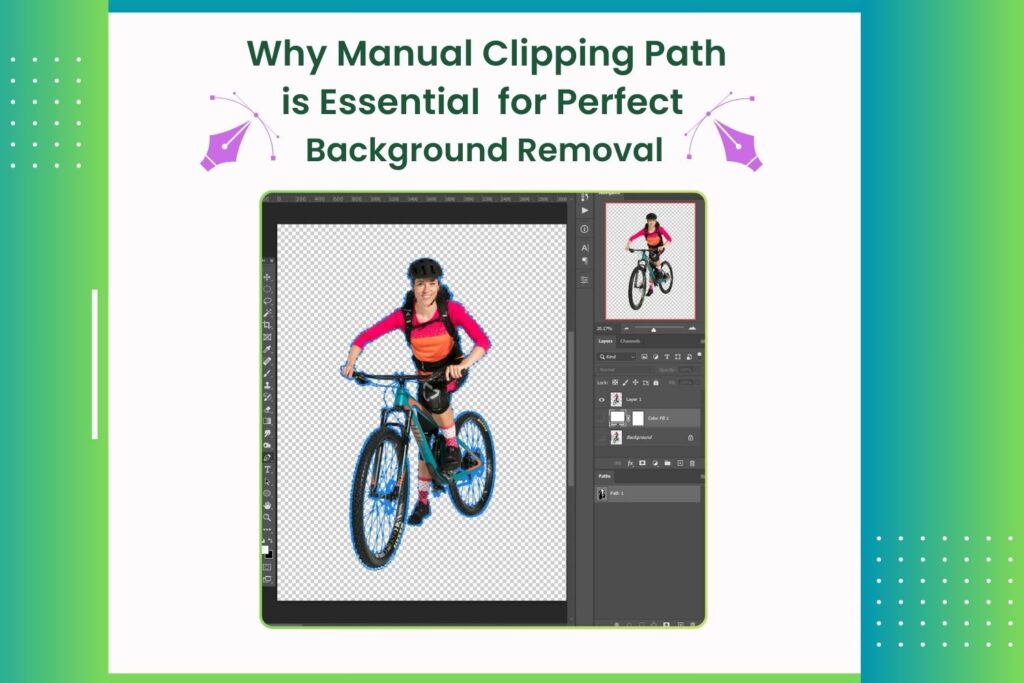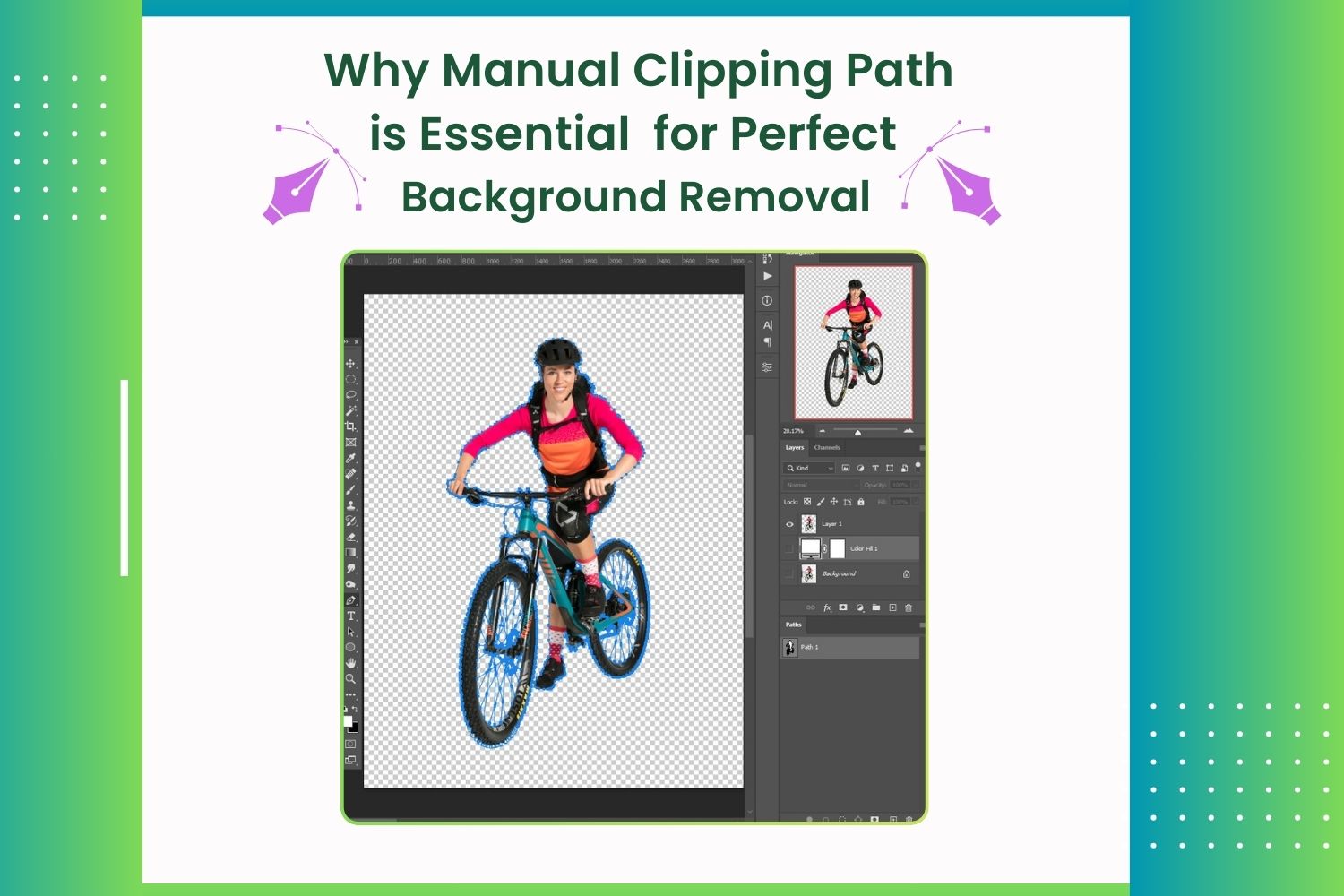Why Manual Clipping Path is Essential for Perfect Background Removal?
When you see a stunning product photo with a pristine white background or an eye-catching advertisement with seamlessly isolated objects, there’s likely a manual clipping path working behind the scenes. This meticulous image editing technique has become the gold standard for professional background removal, delivering results that automated tools simply can’t match.
A clipping path is essentially a vector outline that defines which parts of an image to keep and which to remove or modify. Think of it as drawing a precise boundary around your subject; everything inside stays, everything outside goes. While automated background removal tools have gained popularity, they often struggle with complex edges, fine details, and intricate subjects.
Table of Contents
ToggleA clipping path creates a closed vector outline around an object or subject, effectively isolating it from its background. This technique allows editors to remove, replace, or modify backgrounds while preserving the integrity of the main subject. Unlike simple eraser tools or magic wand selections, clipping paths provide complete control over.
The difference between automated and manual approaches becomes clear when dealing with challenging subjects like flowing hair, transparent materials, or products with intricate details. This is where skilled professionals and the best clipping path service providers demonstrate their value, delivering pixel-perfect results that elevate your visual content. every pixel along the edge.
For businesses investing in visual content, the choice between quick fixes and professional results can significantly impact brand perception and sales performance. Manual clipping path services ensure that every image meets the highest standards, creating the polished appearance that modern consumers expect.
What is a Manual Clipping Path?
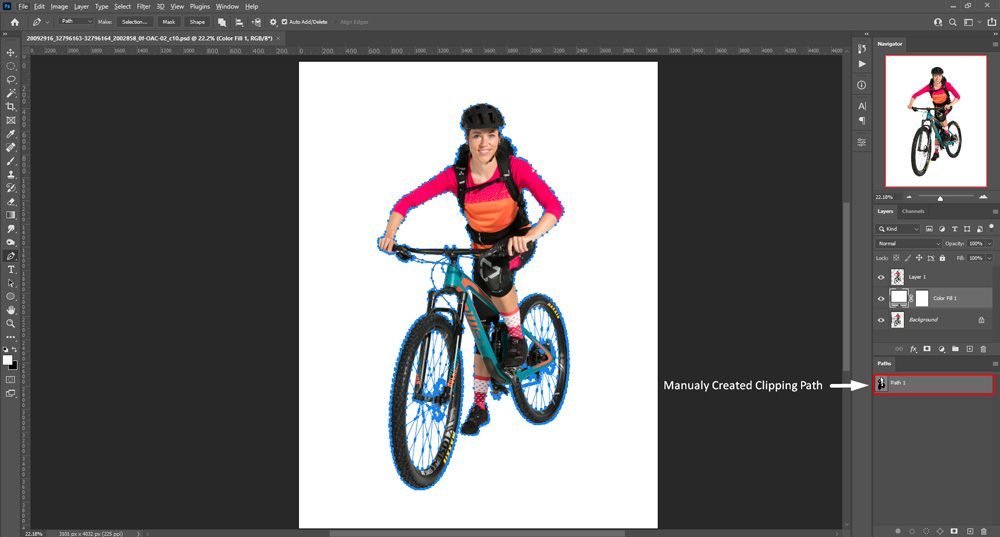
Manual clipping path involves creating vector paths by hand using professional software like Adobe Photoshop. Unlike automated tools that rely on algorithms to detect edges, this technique requires human expertise to carefully trace around objects, ensuring every curve and corner is perfectly captured.
This meticulous process begins with analyzing the image to identify the best approach for isolation. Professionals examine edge complexity, color variations, background elements, and the intended use of the final image. They then create anchor points and adjust curve handles to follow the subject’s contours with mathematical precision.
What sets manual clipping paths apart is the human element. Experienced professionals understand how light interacts with different materials, how shadows should be preserved or removed, and how to handle challenging areas like fine hair strands or transparent elements. They can make judgment calls about what should be included in the final image and what should be excluded.
This hands-on approach also allows for different complexity levels. Simple products with clean, straight edges require basic paths, while complex items like jewelry with multiple facets or clothing with flowing fabric demand more sophisticated techniques. Professional clipping path services categorize these complexity levels to ensure appropriate pricing and turnaround times.
The manual process may take longer than automated alternatives, but the results speak for themselves. Every curve is intentional, every edge is clean, and the final product meets professional standards that can withstand close inspection across various media formats.
Why Manual Clipping Path is Important?
Precision and Accuracy
Manual clipping paths deliver pixel-perfect results that automated tools simply cannot match. Professional editors can distinguish subtle color variations, handle complex transparency issues, and make nuanced decisions about edge treatment. This precision becomes crucial when working with high-value imagery where quality cannot be compromised.
The human eye excels at recognizing patterns and making contextual decisions that algorithms struggle with. A skilled editor can determine whether a shadow should be included or removed, how to handle semi-transparent areas, and where to place anchor points for optimal curve flow. These decisions directly impact the final image quality and professional appearance.
Smooth, Natural-Looking Edges
One of the most significant advantages of manual clipping path services is the ability to create perfectly smooth edges that look natural and believable. Automated tools often produce stair-stepped or jagged edges that immediately reveal the artificial nature of the edit. Manual paths use mathematical curves that create flowing, organic-looking boundaries.
Professional editors understand how to vary curve tension to match the subject’s natural contours. They can create sharp corners where needed while maintaining smooth transitions in curved areas. This attention to edge quality ensures that isolated subjects integrate seamlessly into new backgrounds without telltale signs of editing.
Superior Handling of Complex Images
Complex images present unique challenges that require human problem-solving skills. Overlapping elements, intricate patterns, fine details, and challenging backgrounds all benefit from manual intervention. Automated tools often struggle with these scenarios, producing incomplete selections or unwanted artifacts.
Manual clipping paths excel with subjects like jewelry, where reflective surfaces and transparent gems create complex edge conditions. Similarly, fashion photography with flowing fabrics, layered clothing, and intricate textures requires the careful attention that only manual editing can provide.
Consistency Across Projects
Professional clipping path service providers maintain consistent quality standards across large projects. This consistency is crucial for e-commerce businesses with hundreds or thousands of product images that need uniform background removal. Manual processes ensure that every image meets the same high standards, creating cohesive visual presentations that strengthen brand identity.
Most Popular Use Cases for Manual Clipping Path
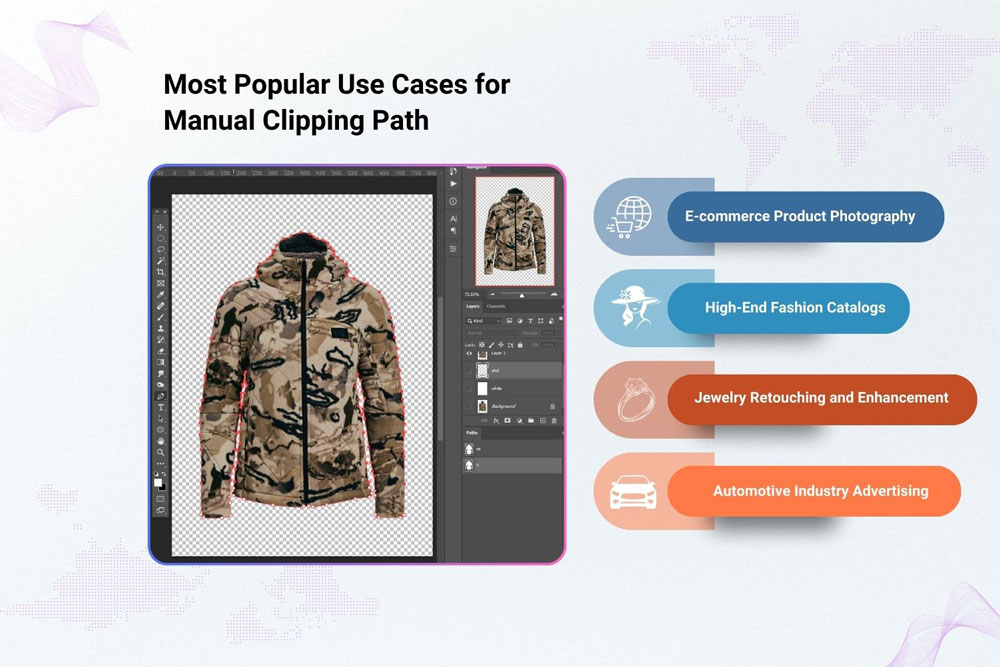
E-commerce Product Photography
Online retailers depend on clean, professional product images to drive sales and build brand credibility. Manual clipping path services ensure that product shots have perfectly clean backgrounds, allowing the merchandise to capture full attention without distractions.
E-commerce platforms often require consistent background colors or transparency for catalog uniformity. Manual clipping paths enable precise background replacement while maintaining product integrity. The investment in professional e-commerce product photo editing pays dividends through improved conversion rates and reduced return rates due to accurate product representation.
Consider a luxury watch retailer showcasing timepieces against various backgrounds. Manual clipping paths ensure that every reflection, curved surface, and intricate detail remains sharp and accurate. The precision extends to maintaining the watch’s natural proportions and preserving important details like crystal clarity and metal finishes.
High-End Fashion Catalogs
Fashion photography demands exceptional attention to detail, particularly when showcasing expensive garments and accessories. Manual clipping paths preserve the subtle textures, flowing lines, and intricate details that define luxury fashion imagery.
High-end fashion catalogs require images that convey quality and sophistication. Every seam, fold, and fabric texture must appear natural and appealing. Manual clipping path services ensure that garments maintain their shape and drape while enabling creative background treatments that enhance the overall aesthetic.
The precision becomes especially important with designer clothing, where construction details, embellishments, and fabric characteristics represent significant value propositions. Automated tools might smooth out important texture details or create unnatural edge artifacts that diminish the garment’s perceived quality
Jewelry Retouching and Enhancement
Jewelry photography presents unique challenges with reflective surfaces, transparent gems, and intricate metalwork. Manual clipping paths enable editors to isolate pieces precisely while preserving the sparkle and brilliance that make jewelry appealing.
Professional jewelry retouching often involves removing unwanted reflections while enhancing desirable ones. Manual clipping paths provide the precision needed to work around complex shapes and maintain the natural light play that gives jewelry its appeal. The technique allows for selective background removal while preserving important reflective elements.
Consider a diamond engagement ring photographed for an online catalog. Manual clipping path services can isolate the ring while preserving the natural light refraction that creates sparkle. The precision extends to maintaining proper proportions and ensuring that every facet appears sharp and brilliant
Automotive Industry Advertising
Vehicle photography for advertising requires exceptional precision to maintain realistic proportions and preserve important design details. Manual clipping paths ensure that cars appear natural and appealing when placed in various promotional contexts.
Automotive advertising often needs retouching or placing vehicles in idealized environments that enhance their appeal. Manual clipping path services provide the accuracy needed to maintain realistic lighting, shadows, and proportions when compositing vehicles into new scenes. The precision ensures that the final images appear natural and believable.
The complexity of modern vehicle design, with curved surfaces, complex lighting, and multiple materials, requires skilled manual editing. Automated tools often struggle with the subtle transitions between paint, glass, chrome, and rubber components that define automotive aesthetics.
Essential Tools and Software
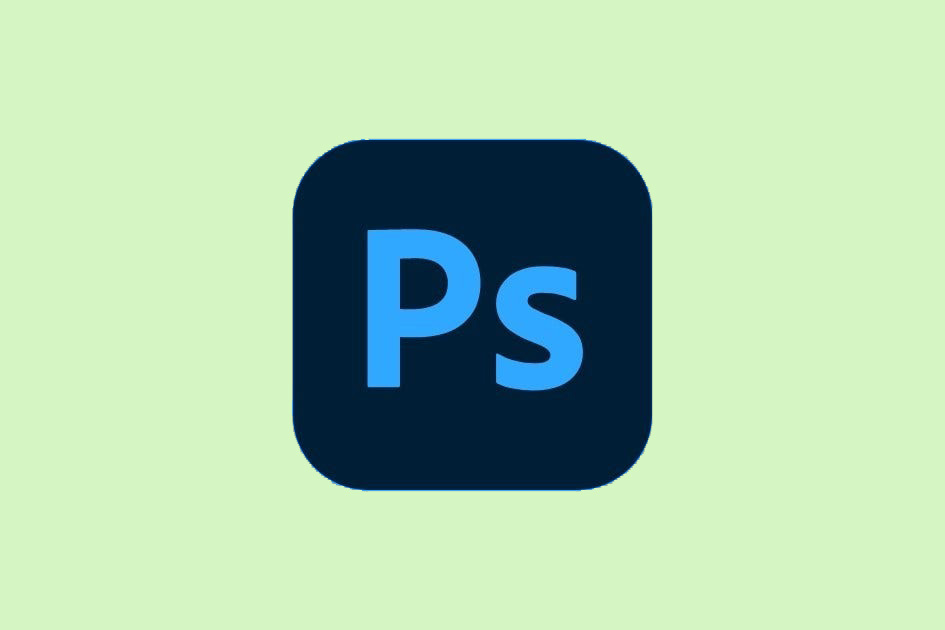
Professional manual clipping path work requires industry-standard software and skilled operators who understand how to maximize these tools’ capabilities. Adobe Photoshop remains the primary choice for most professionals, offering powerful pen tools and path manipulation features essential for precision work.
The Pen Tool serves as the foundation for creating manual clipping paths, allowing designers to create precise vector paths with complete control over anchor points and curve segments. Advanced users combine this with other tools like the Magnetic Pen Tool for semi-automatic assistance in high-contrast areas.
Professional clipping path service providers invest in high-end hardware to support this demanding work. High-resolution monitors ensure accurate color correction and enhanced detail visibility, while graphics tablets provide the precision control necessary for creating complex paths.
Training and experience remain the most critical factors in manual clipping path quality. The best clipping path service providers employ skilled professionals who understand color theory, composition, and technical aspects of digital imaging alongside their software expertise.
DIY vs. Professional Manual Clipping Path Services
DIY Approach: Pros and Cons

Creating manual clipping paths requires significant time investment and skill development. While the tools are accessible, achieving professional-quality results demands extensive practice and attention to detail. The learning curve can be steep, particularly for complex images or high-volume requirements.
DIY approaches work best for simple images with clear edge definition and limited complexity. However, the time investment often exceeds expectations, and the quality may not meet professional standards. Businesses must consider whether internal resources are better allocated to core activities rather than specialized image editing tasks.
The software licensing costs, training time, and ongoing skill maintenance represent hidden expenses in DIY approaches. Additionally, consistency across large image volumes becomes challenging without dedicated expertise and quality control processes.
Professional Service Advantages

Professional manual clipping path services bring specialized expertise, advanced tools, and established workflows to image editing projects. Service providers invest in ongoing training, software updates, and quality control systems that ensure consistent results across all projects.
Professional services offer scalability advantages for businesses with varying image editing needs. Rather than maintaining internal capacity for peak requirements, organizations can access professional expertise on-demand while focusing resources on core business activities.
Quality control represents a significant advantage of professional services. Established providers implement multi-stage review processes, consistency checks, and revision procedures that ensure final deliverables meet specified requirements. This systematic approach reduces the risk of quality issues that could impact brand perception or sales performance.
The best clipping path service provider combines technical expertise with understanding of different industry requirements. They adapt their approach based on the intended use of images, whether for web display, print production, or marketing campaigns.
Best Practices for Manual Clipping Path Implementation
Planning and Preparation
Successful manual clipping path projects begin with careful planning and clear communication of requirements. Establishing quality standards, delivery timelines, and revision procedures prevents misunderstandings and ensures project success.
Image assessment should occur before beginning path creation. Professional editors evaluate each image for complexity, potential challenges, and optimal approach. This assessment informs timeline estimates and helps identify images that may require special handling.
File organization and naming conventions become crucial for larger projects. Establishing clear systems for tracking progress, managing revisions, and organizing deliverables prevents confusion and ensures efficient workflow management.
Quality Control and Consistency
Professional manual clipping path services implement systematic quality control measures to ensure consistent results across all images. Multi-stage review processes catch potential issues before final delivery, maintaining high standards throughout large projects.
Consistency checks involve comparing edge treatment, curve smoothness, and detail preservation across similar images. This attention to uniformity ensures that catalog images or marketing materials maintain a cohesive professional appearance.
Documentation of specific requirements and preferences helps maintain consistency across revision cycles and future projects. Professional service providers create detailed project specifications that guide editor decisions and ensure repeatable results.
Optimization for Intended Use
Different applications require different optimization approaches for manual clipping paths. Web display images may prioritize file size efficiency, while print production requires maximum resolution and color accuracy.
Understanding output requirements influences path creation decisions. Editors adjust curve complexity, edge treatment, and detail preservation based on final image size and viewing conditions. This optimization ensures that the manual clipping path service delivers results perfectly suited to the intended application.
Professional providers maintain expertise across various output requirements and can advise clients on optimal approaches for different applications. This consultative approach adds value beyond basic path creation services.
The Bottom Line
Manual clipping path services remain indispensable for achieving professional-quality background removal that meets modern visual standards. The precision, control, and quality that skilled professionals deliver cannot be replicated by automated tools, particularly for complex or high-value imagery.
Businesses investing in professional visual content recognize that quality editing directly impacts brand perception, customer engagement, and sales performance. Manual clipping paths ensure that every image meets the highest standards while providing the flexibility needed for diverse marketing applications.
The choice between DIY approaches and professional services ultimately depends on quality requirements, volume needs, and resource allocation priorities. For organizations serious about visual quality, professional manual clipping path services represent a strategic investment in brand presentation and market competitiveness.
Your Next Steps
Contact Photo Fix Zone today for professional manual clipping path services and ensure perfect background removal for your images. Get a free quote now and see how our expert team can enhance your e-commerce product shots, fashion catalogs, and more. Don’t compromise on quality. Trust Photo Fix Zone for precise and reliable manual clipping paths that make a difference.


